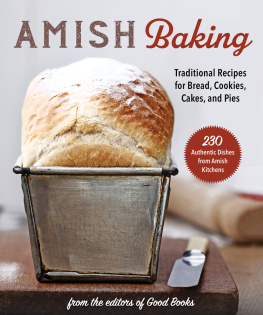The Farmers Wife Baking Cookbook
Over 300 Blue Ribbon Recipes Lela Nargi, Editor


Acknowledgments
I am grateful to
Farm Journal for granting me permission to use text, art, and photos from
The Farmers Wife for the purpose of this cookbook.
To Kari Cornell and MBI Publishing for thinking Id be right for this project.
To Rebecca J. Faille at King Arthur Flour, and Sandra Oliver of
Food History News, for their invaluable research assistance.
To my mother for her good-natured copyediting and common sense.
And to Rob and Ada.


Contents

INTRODUCTION
The Farmers Wife was a monthly magazine published in Minnesota between 1893 and 1939. In an era long before the Internet and high-speed travel connected us all, the magazine aimed to offer community among hard-working rural women by providing a forum for their questions and concerns and assistance in the day-to-day goings on about the farmeverything from raising chickens and slaughtering hogs, to managing scant funds and dressing the children, to keeping house and running the kitchen. The kitchen is where the farmers wife really shone. And of all the various and important tasks she performed there, it was baking that allowed her the broadest arena for expression.
She could be creative in the kitchen, letting her imagination run wild over cakes and cookies and pastries of her own invention. She could show off her skill, whipping up crisp-crusted breads and fine-crumb cakes of the utmost perfection. She could exercise one of the most esteemed qualities among country womenthat of thrift, using the eggs, milk, butter, preserves, and other stores abundant on any farmwhile at the same time showing love and care for her family through the delectable treats she offered them with and between each meal. The farmers wife baked for every circumstance and occasion. She baked all the familys bread, to accompany meals, to slice for sandwiches, and, when stale, to grind for crumbs. At a time when dinner was called supper and no supper was complete without dessert, she baked tarts and pastries to follow-up roasts and stews and casseroles.
She baked cookies and cupcakes to stick in her childrens lunch pails. She baked dainties and muffins to serve at afternoon teas and club luncheons. She baked elaborate cakes for birthdays and weddings. She baked simple pies in great profusion to serve at threshing parties and other large community gatherings.Through the rationing of World War I, the privations of the Great Depression, and the uncertainty of the years leading up to World War II, the farmers wife baked what she hadsometimes absent wheat and sugarand she baked it as well as she could. Perhaps one of the most defining, and surprising, characteristics of the farmers wife was her curiosityabout new techniques and also the world at large. Among the pages of this book youll find many of the things youd expect from the farmers wife: cherry pies, sourdough bread, and layer cakes.
But youll also find recipes for such things as Cornish Pasties and Danish Krandse, because such things, from faraway lands, fascinated the farmers wife, and expanded her baking universe, and often enough, reflected her own heritage;Vinegar Pie and Parkin, rarely to be found these days in baking books but once true stand-bys of the farm kitchen; and so-called Victory breads that use potatoes and cornmeal and other grains to replace or expand wheat flour, because they are poignant reminders of years past, and a testament to the durability and ingenuity of the farmers wife. The recipes have been reprinted here much as they appeared on the pages of the magazine. Most recipes have been taken from issues spanning 1911 to 1939, and many were written by the magazines own readers. In their language, they reflect the curious style and manners of their times, and herein lies a great deal of their charm, and the reason I have chosen to alter them as little as possible. Anyone accustomed to reading cookbooks, and any habitual baker, will feel right at home among the pages of this book. After all, the farmers wife was nothing if not common-sensical, and so were her recipes.
Anyone new to cookbooks, and more particularly, historical cookbooks, is advised to follow the golden rule of the recipe: Read it thoroughly, start to finish and preferably more than once, before embarking. Make sure you understand the instructions and the order in which they are to be carried out; make sure you have all the ingredients at hand and assembled; and make sure to preheat your oven a good 20 to 30 minutes before you are ready to bake. Wherever possible, I have attempted to abolish confusing, misleading, or laborious instructions. Ive also substituted modern equivalents for obsolete measurements such as the gill (4 ounces), and the teacup (8 ounces). More than anything, this book wants to be used, not merely perused and admired. Lela Nargi


HOW TO USE THIS BOOKREAD THIS FIRST

In any recipe, shortening can be substituted for lard.
Lela Nargi


HOW TO USE THIS BOOKREAD THIS FIRST

In any recipe, shortening can be substituted for lard.
The word fat can be interpreted as butteruse accordingly. Quite a number of the original Farmers Wife baking recipes call for sour milk.According to Sandra Oliver, editor of Food History News, sour milk was a naturally occurring product on farms in the days of pre-pasteurization, and was very useful for baking. The acidity in the sour milk interacted with the alkaline in the baking soda to make the gas that raised baked goods, she explains. Ive substituted buttermilk in the recipes that call for sour milk. If youd like to make your own sour milk, add 1 tbsp. sweet milk (a word the











 In any recipe, shortening can be substituted for lard. Lela Nargi
In any recipe, shortening can be substituted for lard. Lela Nargi